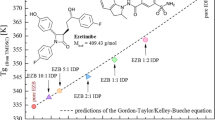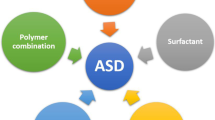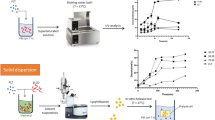Abstract
Limits to the aqueous solubility of emerging new chemical entities, as well as older drug molecules, represent a barrier to solid oral dosage form development. Numerous techniques are conventionally employed in aqueous solubility enhancement, although a universal strategy has proven elusive. Formation of binary solid composites, such as eutectics or amorphous solid dispersions, offers an alternative to traditional solubility enhancement techniques. The reality of these systems, however, is that very few examples have been made commercially available, ultimately stemming from a lack of understanding regarding structural and thermodynamic stability-indicating phenomena associated with higher-energy solid materials. In the present work, a comprehensive structurally based review of the fundamental solid-state properties of binary composite materials is presented. Specific emphasis is placed on current topics of research in the area of binary composite formation and the relationship to the underutilization of this technology with the pharmaceutical industry.



Similar content being viewed by others

References
Amidon GL, et al. A theoretical basis for a biopharmaceutic drug classification: the correlation of in vitro drug product dissolution and in vivo bioavailability. Pharm Res 1995;12(3):413–20.
Fleisher D, Bong R, Stewart BH. Improved oral drug delivery: solubility limitations overcome by the use of prodrugs. Adv Drug Deliv Rev 1996;19:115–30.
Morris KR, et al. An integrated approach to the selection of optimal salt form for a new drug candidate. Int J Pharm 1994;105(3):209–17.
Serajuddin ATM. Salt formation to improve drug solubility. Adv Drug Deliv Rev 2007;59:603–13.
Sinko PJ. Martin’s physical pharmacy and pharmaceutical sciences. 5th ed. Philadelphia: Lippincott Williams & Wilkins; 2006.
Krise JP, Narisawa S, Stella VJ. A novel prodrug approach for tertiary amines. 2. Physicochemical and in vitro enzymatic evaluation of selected N-phosphonooxymethyl prodrugs. J Pharm Sci 1999;88(9):922–7.
Noyes AA, Whitney WR. The rate of dissolution of solid substances in their own solutions. J Am Chem Soc 1897;19:930–4.
Byrn SR, Pfeiffer RR, Stowell JG. Solid state chemistry of drugs. 2nd ed. West Lafayette: SSCI; 1999.
Wildfong PLD, et al. Demonstration of a shear-based solid-state phase transformation in a small molecular organic system: chlorpropamide. J Pharm Sci 2007;96(5):1100–13.
Lin Y, Cogdill RP, Wildfong PLD. Informatic calibration of a materials properties database for predictive assessment of mechanically activated disordering potential for small molecule organic solids. J Pharm Sci 2009. doi:10.1002/jps.21647.
Wildfong PLD, et al. Towards an understanding of the structurally based potential for mechanically activated disordering of small molecule organic crystals. J Pharm Sci 2006;95(12):2645–56.
Zhang GGZ, et al. Phase transformation considerations during process development and manufacture of solid oral dosage forms. Adv Drug Deliv Rev 2004;56:371–90.
Loftsson T, Brewster ME. Pharmaceutical applications of cyclodextrins. 1. Drug solubilization and stabilization. J Pharm Sci 1996;85(10):1017–25.
Li P, Zhao L. Developing early formulations: practice and perspective. Int J Pharm 2007;341:1–19.
Kaushal AM, Gupta P, Bansal AK. Amorphous drug delivery systems: molecular aspects, design, and performance. Crit Rev Ther Drug Carr Syst 2004;21:133–93.
Porter DA, Easterling KE. Phase transformations in metals and alloys.New York: Van Nostrand Reinhold; 1981.
Woolliams ER, et al. Metal (carbide)-carbon eutectics for thermometry and radiometry: a review of the first seven years. Metrologia 2006;43:R11–25.
Askeland DR, Phule PP. The science and engineering of materials. 5th ed. Toronto: Thompson; 2006.
Bansal SS, Kaushal AM, Bansal AK. Molecular and thermodynamic aspects of solubility advantage from solid dispersions. Mol Pharm 2007;4(5):794–802.
Leuner C, Dressman J. Improving drug solubility for oral delivery using solid dispersions. Eur J Pharm Biopharm 2000;50:47–60.
Serajuddin ATM. Solid dispersion of poorly water-soluble drugs: early promises, subsequent problems, and recent breakthroughs. J Pharm Sci 1999;88(10):1058–66.
Vasconcelos T, Sarmento B, Costa P. Solid dispersions as strategy to improve oral bioavailability of poor water soluble drugs. Drug Discov Today 2007;12(23/24):1068–75.
Kukushkin SA, Grigoriev DA. Theory of the late-stage crystallization of eutectic composition melts. J Phys Chem Solids 2000;61:1337–43.
Margarit MV, Marin MT, Contreras MD. Solubility of solid dispersions of pizotifen malate and povidone. Drug Dev Ind Pharm 2001;27(6):517–22.
Nazzal S, et al. Preparation and in vitro characterization of a eutectic based semisolid self-nanoemulsified drug delivery system (SNEDDS) of ubiquinone: mechanism and progress of emulsion formation. Int J Pharm 2002;235:247–65.
Rombach E, Ulrich J. Self-controlled coating process for drugs. Cryst Growth Des 2007;7(9):1618–22.
Sakata Y, et al. Effects of solid-state reaction between paracetamol and cloperastine hydrochloride on the pharmaceutical properties of their preparations. Int J Pharm 2007;335:12–9.
Meng G, Lin X, Huang W. The relationship between effective entropy change and volume fraction of the eutectic phases in eutectic microstructures. Mater Lett 2008;62:984–7.
Hunt JD, Jackson KA. Binary eutectic solidification. Trans Metall Soc AIME 1966;236(6):843–52.
Law D, et al. Properties of rapidly dissolving eutectic mixtures of poly(ethylene glycol) and fenofibrate: the eutectic microstructure. J Pharm Sci 2003;92(3):505–15.
Yong CS, et al. Preparation of ibuprofen-loaded liquid suppository using eutectic mixture system with menthol. Eur J Pharm Sci 2004;23:347–53.
Chiou WL, Riegelman S. Pharmaceutical applications of solid dispersions. J Pharm Sci 1971;60:1281–302.
Qi S, et al. Characterisation of solid dispersions of paracetamol and Eudragit E prepared by hot-melt extrusion using thermal, microthermal and spectroscopic analysis. Int J Pharm 2008;354:158–67.
Konno H, Taylor LS. Influence of different polymers on the crystallization tendency of molecularly dispersed amorphous felodipine. J Pharm Sci 2006;95(12):2692–705.
Miyazaki T, et al. Ability of polyvinylpyrrolidone and polyacrylic acid to inhibit the crystallization of amorphous acetaminophen. J Pharm Sci 2004;93:2710–7.
Tang XC, Pikal MJ, Taylor LS. A spectroscopic investigation of hydrogen bond patterns in crystalline and amorphous phases in dihydropyridine calcium channel blockers. Pharm Res 2002;19:477–83.
Taylor LS, Zografi G. Spectroscopic characterization of interactions between PVP and indomethacin in amorphous molecular dispersions. Pharm Res 1997;14:1691–8.
Waard Hd, et al. Unexpected differences in dissolution behavior of tablets prepared from solid dispersions with a surfactant physically mixed or incorporated. Int J Pharm 2008;349:66–73.
Craig DQM. The mechanisms of drug release from solid dispersions in water-soluble polymers. Int J Pharm 2002;231:131–44.
Karavas E, et al. Investigation of the release mechanism of a sparingly water-soluble drug from solid dispersions in hydrophilic carriers based on physical state of drug, particle size distribution and drug–polymer interactions. Eur J Pharm Biopharm 2007;66:334–47.
Anguiano-Igea S, et al. The properties of solid dispersions of clofibrate in polyethylene glycols. Pharm Acta Helv 1995;70:57–66.
Docoslis A, et al. Characterization of the distribution, polymorphism, and stability of nimodipine in its solid dispersions in polyethylene glycol by micro-Raman spectroscopy and powder X-ray diffraction. AAPS J 2007;9(3):361–70.
Law D, et al. Physicochemical considerations in the preparation of amorphous ritonavir–poly(ethylene glycol) 8000 solid dispersions. J Pharm Sci 2001;90(8):1015–25.
Sekiguchi K, Obi N. Studies on absorption of eutectic mixtures. I. A comparison of the behavior of eutectic mixtures of sulphathiazole and that of ordinary sulphathiazole in man. Chem Pharm Bull 1961;9:866–72.
Tachibana T, Nakamura A. A method for preparing an aqueous colloidal dispersion of organic materials by using water-soluble polymers: dispersion of beta-carotene by polyvinylpyrrolidone. Colloid Polym Sci 1965;203:130–3.
Lacoulonche F, Chauvet A, Masse J. An investigation of flurbiprofen polymorphism by thermoanalytical and spectroscopic methods and a study of its interactions with poly-(ethylene glycol) 6000 by differential scanning calorimetry and modelling. Int J Pharm 1997;153:167–79.
Lacoulonche F, et al. An investigation of FB interactions with poly(ethylene glycol) 6000, poly(ethylene glycol) 4000, and poly-e-carpolactone by thermoanalytical and spectroscopic methods and modeling. J Pharm Sci 1998;87(5):543–51.
Lheritier J, et al. Improvement of the dissolution kinetics of SR 33557 by means of solid dispersions containing PEG 6000. Int J Pharm 1995;123:273–9.
Naima Z, et al. Interactions between carbamazepine and polyethylene glycol (PEG) 6000: characterisations of the physical, solid dispersed and eutectic mixtures. Eur J Pharm Sci 2001;12:395–404.
Stott PW, Williams AC, Barry BW. Transdermal delivery from eutectic systems: enhanced permeation of a model drug, ibuprofen. J Control Release 1998;50:297–308.
Harding LJ, Reading M, Craig DQM. The development of thermally assisted particle manipulation and thermal nanointeraction studies as a means of investigating drug–polymer interactions. J Pharm Sci 2008;97(4):1551–63.
Chen Y, et al. Enhancing the bioavailability of ABT-963 using solid dispersion containing Pluronic F-68. Int J Pharm 2004;286:69–80.
Stott PW, Williams AC, Barry BW. Mechanistic study into the enhanced transdermal permeation of a model beta-blocker, propranolol, by fatty acids: a melting point depression effect. Int J Pharm 2001;219:161–76.
Yuan X, Capomacchia AC. The binary eutectic of NSAIDs and two-phase liquid system for enhanced membrane permeation. Pharm Dev Technol 2005;1:1–10.
Larrea A, Orera VM. Porous crystal structures obtained from directionally solidified eutectic precursors. J Cryst Growth 2007;300:387–93.
Mullen JW. Crystallization. 4th ed. Woburn: Reed; 2001.
Osborn JC, et al. Proceedings from the 14th International Symposium on Industrial Crystallization. Cambridge, UK; 1999.
Bi M, Hwang SJ, Morris KR. Mechanism of eutectic formation upon compaction and its effects on tablet properties. Thermochim Acta 2003;404:213–26.
Law D, et al. Prediction of poly (ethylene) glycol–drug eutectic compositions using an index based on the van’t Hoff equation. Pharm Res 2002;19(3):315–21.
Craig DQM. A review of thermal methods used for the analysis of the crystal form, solution thermodynamics and glass transition behaviour of polyethylene glycols. Thermochim Acta 1995;248:189–203.
Newa M, et al. Preparation, characterization and in vivo evaluation of ibuprofen binary solid dispersions with poloxamer 188. Int J Pharm 2007;343:228–37.
Smikalla MM, Urbanetz NA. The influence of povidone K17 on the storage stability of solid dispersions of nimodipine and polyethylene glycol. Eur J Pharm Biopharm 2007;66:106–12.
Huang J, Wigent RJ, Schwartz JB. Drug–polymer interaction and its significance on the physical stability of nifedipine amorphous dispersion in microparticles of an ammonio methacrylate copolymer and ethyl cellulose binary blend. J Pharm Sci 2008;97(1):251–62.
Janssens S, et al. Physical stability of ternary solid dispersions of itraconazole in polyethylene glycol 6000/hydroxypropylmethylcellulose 2910 E5 blends. Int J Pharm 2008;355:100–7.
Zhang X, et al. Physical characterization of lansoprazole/PVP solid dispersion prepared by fluid-bed coating technique. Powder Technol 2008;182:480–5.
Chokshi R, Zia H. Hot-melt extrusion technique: a review. Iran J Pharma Res 2004;3:3–16.
Papadimitriou SA, Bikiaris D, Avgoustakis K. Microwave-induced enhancement of the dissolution rate of poorly water-soluble tibolone from poly(ethylene glycol) solid dispersions. J Appl Polym Sci 2008;108:1249–58.
Xu L, Li SM, Sunada H. Preparation end evaluation of ibuprofen solid dispersion systems with Kollidon particles using a pulse combustion dryer system. Chem Pharm Bull 2007;55(11):1545–50.
Sethia S, Squillante E. Solid dispersion of carbamazepine in PVP K30 by conventional solvent evaporation and supercritical methods. Int J Pharm 2004;272:1–10.
Dong Z, et al. Evaluation of solid state properties of solid dispersions prepared by hot-melt extrusion and solvent co-precipitation. Int J Pharm 2008;355:141–9.
West AR. Basic solid state chemistry. 2nd ed. Hoboken: Wiley; 1999.
Hancock BC, Zografi G. Characteristics and significance of the amorphous state in pharmaceutical systems. J Pharm Sci 1997;86(1):1–12.
Zhou D, et al. A calorimetric investigation of thermodynamic and molecular mobility contributions to the physical stability of two pharmaceutical glasses. J Pharm Sci 2007;96(1):71–83.
Mooter GVd, et al. Physical stabilisation of amorphous ketoconazole in solid dispersions with polyvinylpyrrolidone K25. Eur J Pharm Sci 2001;12:261–9.
Marsac PJ, et al. Recrystallization of nifedipine and felodipine from amorphous molecular level solid dispersions containing poly(vinylpyrrolidone) and sorbed water. Pharm Res 2007;25(3):647–56.
Gordon M, Taylor JS. Ideal copolymers and the second-order transitions of synthetic rubbers. I. Noncrystalline copolymers. J Appl Chem 1952;2:493–500.
Matsumoto T, Zografi G. Physical properties of solid molecular dispersions of indomethacin with poly(vinylpyrrolidone) and poly(vinylpyrrolidone-co-vinyl-acetate) in relation to indomethacin crystallization. Pharm Res 1999;16(11):1722–8.
Newman A, et al. Characterization of amorphous API: polymer mixtures using X-ray powder diffraction. J Pharm Sci 2008;97(11):4840–56.
Nowers JR, et al. Combinatorial methods and informatics provide insight into physical properties and structure relationships during IPN formation. Macromol Rapid Commun 2007;28:972–6.
Rajan K. Materials informatics. Materials Today 2005;8(10):38–45.
Acknowledgments
The authors would like to thank Dr. Jennifer Aitken and Dr. David Engers for their valuable suggestions during the preparation of this review.
Author information
Authors and Affiliations
Corresponding author
Rights and permissions
About this article
Cite this article
Moore, M.D., Wildfong, P.L.D. Aqueous Solubility Enhancement Through Engineering of Binary Solid Composites: Pharmaceutical Applications. J Pharm Innov 4, 36–49 (2009). https://doi.org/10.1007/s12247-009-9053-7
Received:
Accepted:
Published:
Issue Date:
DOI: https://doi.org/10.1007/s12247-009-9053-7



